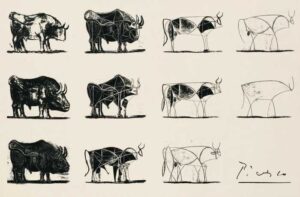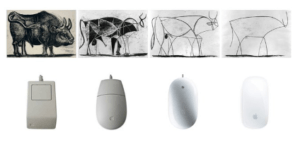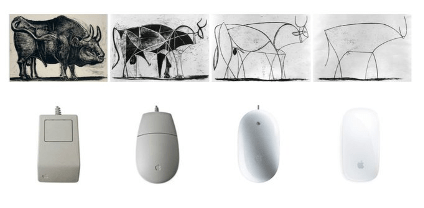
Preparing for Exploration
Apple is a prime example of how art can have a profound impact on business success, well beyond the traditionally perceived realm of design and creativity.
Pablo Picasso created the iconic “El Toro” series in 1945 at the age of 64. More than 50 years later, Apple incorporated the principles of this series into its business culture and employee training.
It wasn’t until 2014, when the New York Times managed to peek inside Apple’s highly secretive employee training program at Apple University, that this connection between Picasso’s work and Apple’s business culture was made explicit to the public.
“El Toro” is a set of eleven lithographs, in which Picasso visually dissects the image of a bull to uncover its ‘essence’. He provides a masterful lesson on the process of creating a work of art from academic to abstract.
El Toro

Picasso displayed his adaptability by returning to lithography, an ideal medium for adding or removing elements, after decades of creating successful artworks in other mediums. He also highlighted blending skills by partnering with printmaker Mourlot.
The first lithograph is realistic, inspired by Francisco Goya’s Romanticism style (1746-1826), the second one (on 1st column) below expands and gives mythical presence, the third at the bottom dissects anatomy using lines and textures.
From the fourth (top of 2nd column) to ninth lithograph Picasso abstracts the bull, simplifying and stylizing it by removing lines, highlighting balance and embracing “less is more”.
In his last two lithographs, Picasso simplified the images by removing all unnecessary details to uncover the essence of the bull, merging elements of ancient cave paintings with modern abstraction.
Picasso’s lithography work was guided by three principles: 1) “the need to distill an image into its essence”, 2) “Good artists copy, great artists steal” and 3) “A picture is a sum of destructions” (1).
The latter principle, emphasizing simplicity, refers to two notable figures: the German architect Ludwig Mies van der Rohe (1886-1969), credited with popularizing “less is more”, and the Renaissance polymath Leonardo da Vinci (1452-1519) is often credited with coining the expression “Simplicity is the ultimate sophistication”.
(1) A picture is a sum of destructions” is a Picasso quote that subverts the original principle that “a picture is a sum of additions”.
| Picasso guiding Principles, adopted by Apple: |
| “The need to uncover the ‘essence”
“A picture is a sum of destructions” “Less is More” “Good artists copy, great artists steal” Copying: duplicates. Stealing: take inspiration and add own touch, creating something unique |
These principles of Picasso were later embraced by Steve Jobs, Indeed, the founder of Apple, emphasized the importance of understanding the essence of one’s business to eliminate (“destroy”) unnecessary elements and innovate primarily by connecting new and existing (“Stealed”) ideas.
Steve Jobs publicly acknowledged these principles as essential to Apple’s philosophy and integrated their study in Apple University’s “What Makes Apple, Apple” course.
Interestingly, at the end of Apple’s iconic ‘Think Different’ advertisement, a clip of Picasso drawing a bull underscores how closely Apple was aligned with the artist´s principles:
When analyzing Apple’s strategy, we can observe the application of these principles in various domains, including Customer Focus, Organization Balance, Value Chain, Acquisitions, Product Portfolio and New Product Development.
Business Leadership Insights
While attention often centers on Apple and Picasso’s innovation and design, their relationship yields broader leadership insights. Business leaders can draw inspiration to reevaluate critical areas for their company’s success:
- Customer Oriented company – Apple fiercely seeks to identify customers’ essence and hidden needs and priorities. Subsequently, Apple designs and simplifies its offerings while reducing its value chain to the minimal assets required to deliver that value proposition.
“Our job is to figure out what customer are going to want before they do. I think Henry Ford once said, “If I’d asked customers what they wanted, they would have told me, A faster horse!” Steve Jobs.
- Reverse Value Chain – Apple reverses the traditional value chain, as it starts by identifying (hidden) customer needs and priorities and working backward to the raw materials, not the other way around. This leads to effective products and streamlines the value chain.
Most companies make similar claims about their customer-centric approaches. However, upon closer examination, many use the traditional value chain, concentrating their discussions on activities unrelated to customers and that ultimately do not create customer value.
“You’ve got to start with the customer experience and work back toward the technology – not the other way around”, Steve Jobs.
- Organization Balance – Like Picasso reduces the bull to its essence while maintaining an overall balance, Apple keeps its organizational center of gravity closer to customers (e.g. in terms of decision-makers, budget, personnel), avoiding an excessive focus on technology or design without utility for customers.
”The design of the Mac wasn’t what it looked like, although that was part of it. Primarily, it was how it worked”, Steve Jobs.
- “Steal” Ideas through Acquisitions – Apple’s M&A strategy centers on acquiring small companies to ‘steal’ their innovative ideas. The small size of the acquired companies facilitates integration into Apple’s business model, enabling ideas to reach new heights.
“We have always been shameless about stealing great ideas”, Steve Jobs.
- A Lean Product Portfolio and fearless innovation – Apple has embraced a minimalist product portfolio, fearlessly releasing new products that replace successful ones, as long as they better met customers’ needs.
- Creativity and New Product Development– Picasso’s influence in Apple is evident in these areas. In their ability to capture the essence while eliminating non-essentials, generate and adopt ideas, and blend innovation with classical elements. As Steve Jobs famously said, they “simply connect things”.

In 1979, Jobs was introduced to the mouse at Xerox PARC. Instead of simply copying the idea, he improved upon it to create the Magic Mouse, with a more user-friendly design.
This Mouse is a symbol of Apple’s commitment to minimalism, exemplified by its complete elimination of buttons (“A Picture is a sum of destructions”).
“he’d rather be the best than the first to introduce a product”, Tim Cook, CEO of Apple
A clear and simple mindset that focuses on capturing the essence and clarity of goals helps to produce offers that clients love and to eliminate unnecessary details throughout the organization. This, in turn, helps to achieve disproportionate profitability.
Additionally, the Picasso and Steve Jobs examples offer valuable lessons for leaders on broader topics:
Picasso’s profound understanding of art history and mastery of various mediums contributed significantly to his success, while Jobs emphasized the importance of collaborating with individuals from diverse and exceptional backgrounds.
Picasso and Jobs’s constant reinvention, even in the face of success, inspires business leaders to take courageous risks for continued growth.
However, they also recognized that qualities such as perseverance, passion, and diligence are essential for achieving success.
‘Simplifying complexity demands dedicated effort, enabling individuals to overcome challenges, and perseverance distinguishes thriving entrepreneurs from unsuccessful ones”, Steve Jobs
Is it time for Apple to rediscover the transformative power of art?
Recent strategies, like global expansion, integrated peripheral products and seamless ecosystem integration, supported by recurring revenue models, drive Apple’s impressive growth and resilience.
However, a prolonged departure from Picasso and Jobs’s principle of “constant reinvention, even in the face of success” suggests a growing need for Apple to prioritize reinventing itself for sustained long-term growth, rather than merely continuing to refine existing concepts—similar to Picasso’s shift from a successful Rose phase to the transformative Cubism phase.
* * *
Finally, to achieve success in implementing a business model, especially in the service sector that often charges by the hour, leaders should derive a final and crucial insight from Picasso on pricing:
During a meal, according to legend, by request Picasso sketched a woman’s portrait on a napkin. The woman exclaimed, “You captured my essence with one stroke, Fantastic!” She asked how much she owed him, and he replied, “one hundred thousand dollars.” When she expressed surprise, he said, “Madame, it took me my entire life to learn how to capture a person’s essence with one stroke.”
Now you see why Apple prices high, but you still pay!
Jose Taboada – Corporate Strategist | Founder of Artcipation
Key Sources: New York Times, Apple
© 2024 Artcipation
Other related Articles:
“Picasso in Fontainebleau: An Inspiring MoMA Exhibition for Business Leaders” (Open through February 17, 2024)
“Picasso Artistic life: A Source of Inspiration for Business Leader”
Comment Article on:
Do you want to receive more information about this topic?
AI fraud system restricts importing personal data from apps
Subscribe our Mailing List today!


Leave a Reply